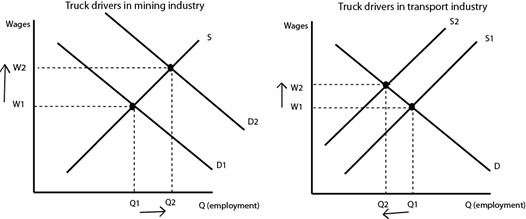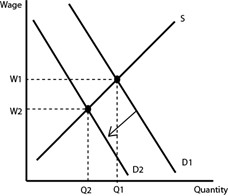Application Exercise 4a: Price mechanism at work during the mining boom and beyond.

1) The major factor was the strong growth in emerging economies such as China and India which resulted in a huge demand for and price of those resources/commodities in which Australia was a major global producer.
2) Because increasingly funds were being channeled into the growing mining sector which ultimately meant that there was an increase in the opportunity cost of maintaining funding within the manufacturing industry at previous levels/rates.
3) When the demand for one type of labour increases relative to the supply (e.g. mining workers during the mining boom) it causes an increase in wage or price of labour in that particular market (e.g. there is an increase in the price of mining labor relative to the price of labour in other industries). This attracts labour from other industries, markets or sectors who are seeking the relatively higher remuneration on offer in those labour markets where a price of labor is increasing. For example, the high relative price of mining labour resulted in workers moving to the mining industry from other Industries (I.e. labour resources are reallocated from one Industry to another).

4) The reduction in the supply of labour in other industries (e.g. the transportation industry) resulted in higher costs to transport goods for other industries, including the manufacturing industry. In addition, some workers previously working in the manufacturing industry will also have been enticed to move to the mining industry in search of higher wages which exerted upward pressure on wages for workers in the manufacturing industry, once again resulting in an increase in manufacturing costs.
5) Higher labour costs in the manufacturing industry means that the cost of labour Wage
6) Relative to capital (e.g. machinery) has increased. This is likely to result in some substitution away from labour and into capital. In other words, the higher wages bill faced by manufacturers will entice some manufacturers to rely less on labour and instead invest more in machinery/robotics, etc.
- The investment in new technologies on mines for example (such as remote Controlled trucks and trains) will eventually lead to a reduction in the demand for labour and a corresponding drop in mining wages, as shown in the demand and supply diagram to the right.

7) The end of the mining boom means that labour markets in mining states such as Western Australia and Queensland will no longer be in a state of excess demand, which will result in workers relocating to other regions or states. This effectively increases the supply of labour in most other industries which ultimately helps to maintain downward pressure on the price of labour or labour costs.
